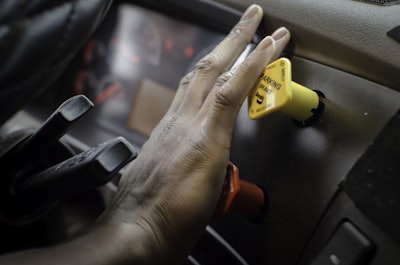 Once FMCSA begins gleaning data on behind-the-wheel time from driver trainers, it could set a behind-the-wheel training time minimum, CVTA’s Don Lefeve says. (Photo by Jim Allen/365 Trucking)
Once FMCSA begins gleaning data on behind-the-wheel time from driver trainers, it could set a behind-the-wheel training time minimum, CVTA’s Don Lefeve says. (Photo by Jim Allen/365 Trucking)Despite a two-month delay prompted by a recent order from President Trump and pressure from safety groups to alter one of the its key elements, a U.S. DOT rule establishing national training standards for entry-level truckers will proceed as scheduled, says Don Lefeve, president of the Commercial Vehicle Training Association. CVTA is a trade group representing driver schools and other training providers, like fleets who perform in-house driver training.
Several groups, including the Owner-Operator Independent Drivers Association, have decried the rule’s lack of a behind-the-wheel time minimum. The agency originally proposed a 30-hour behind-the-wheel minimum, to be split between a driving range and on-road driving.
FMCSA nixed the minimum in the Final Rule, opting instead for a proficiency-based requirement. FMCSA-approved trainers will determine driver trainees’ proficiency, according to the rule.
The rule was published in early December and was scheduled to become law Feb. 6. A short-term regulatory freeze issued by Trump Jan. 20 delayed the rule’s effective date to March 21. The Feb. 7, 2020, compliance date has not been moved. The rule has three main components: Setting a classroom curriculum for driver trainees, requiring behind-the-wheel training and creating a registry of certified trainers from which trainees must use.
Recent hurdles aside, including calls from various groups for FMCSA to issue a supplemental rule to add a time-based behind-the-wheel requirement, the rule likely will remain as-is through its 2020 implementation date, says Lefeve.
OOIDA in December banned with several safety groups — Advocates for Auto and Highway Safety, the Truck Safety Coalition and Citizens for Reliable and Safe Highways — to petition FMCSA to reinstate the 30-hour behind-the-wheel minimum. The Professional Truck Driver Institute followed their lead last week.
Such efforts to reform the rule before then are “dead in the water,” Lefeve says.
“That decision was made by the [Office of Management and Budget],” he says. “It’s not saying that there’s not going to be any hours. It’s just saying it’s a true proficiency or outcome-based requirement. This isn’t a one and done approach. It requires repetition to become proficient.”
Trainers will be required to submit to FMCSA the number of hours of behind-the-wheel training each driver trainee receives. This data could lead FMCSA to institute a minimum behind-the-wheel requirement after the rule takes effect, Lefeve says. “They want to collect the data, because we simply do not know whether 30 hours equals safety,” he says. “By collecting the data they’ll start to be able to put more science behind that.”
Trump’s recent regulatory policies shouldn’t jeopardize the training regs either, Lefeve says. The MAP-21 highway act, which became law in 2012, required FMCSA to finalize the rule within a year — a deadline it missed by three years. “We’re three years late and going to wrap this up into a reg freeze?” Lefeve says. “Honestly we were a little confused why it was even incorporated into the so-called freeze.” Rules with statutory deadlines from Congress, like the driver training rule, were noted exceptions in Trump’s order, Lefeve says.










